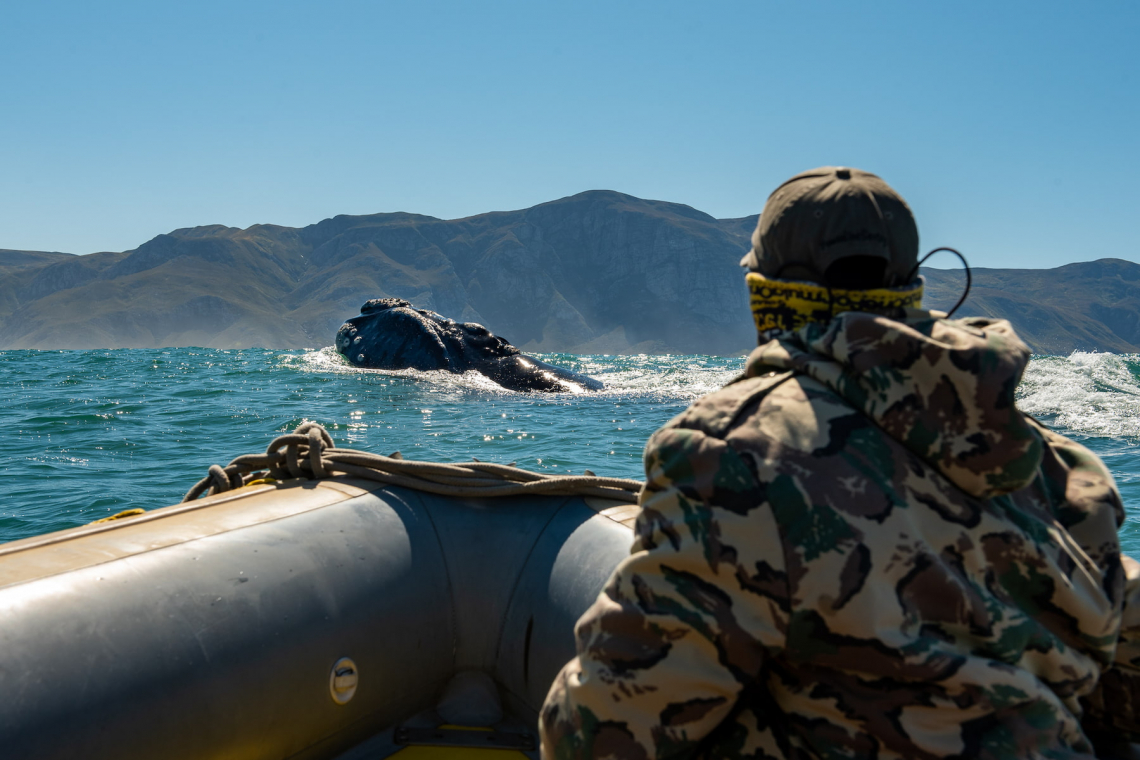Preliminary 2022 surveys indicate that the number of southern right whales between Hermanus and Witsand is better than in 2019, 2020 and 2021.
Since their international protection in 1935, southern right whale population has increased substantially from a mere 60 reproductive females in 1920 to some 15,000 individuals. The South African population, which occupies seasonal calving and nursery grounds in the nearshore and protected waters of the southern Cape coast, is believed to be the largest breeding stock of the global population, comprising some 6,300 individuals.
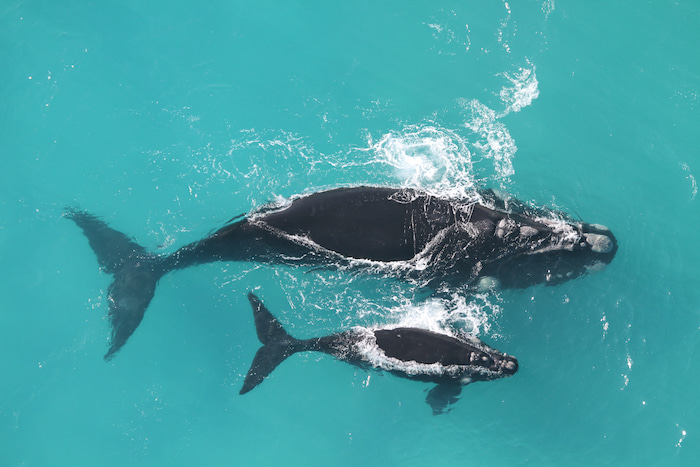
Southern right whale and calf
To monitor the population recovery post-whaling, annual aerial surveys have been initiated in 1969 by the late Prof Peter Best. From 1979, such surveys have incorporated photo-identification, a method by which individual whales are identified through overhead photographs of the callosity pattern on the head. This 53-year long database (including 43 years of individual sighting histories) is one of the longest uninterrupted datasets in the world on any marine mammal, and provides critical information for the estimation of demographic parameters of the population (including, for example, population size and trend, calving intervals, survival rates and age at first calving).
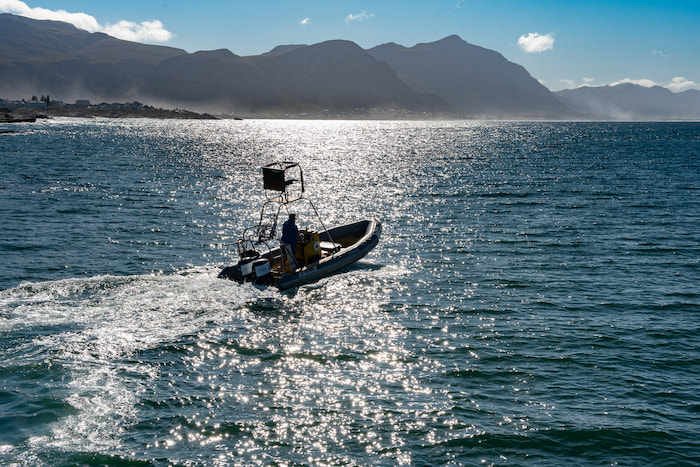
Mammal Research Institute Whale Unit early morning departure
Preliminary count surveys conducted by Mammal Research Institute Whale Unit at the beginning of August this year indicated the number of right whales between Hermanus and Witsand is better than what it has been in 2019, 2020 and 2021, with 248 females with calves (496 individuals) and 40 unaccompanied adults counted, leading to a total of 536 southern right whales on this stretch of coastline at that time. This is about 50% more than what was seen last year around the same time, but still below the number of southern right whales we would expect on our coastline this time of year under “normal conditions”.
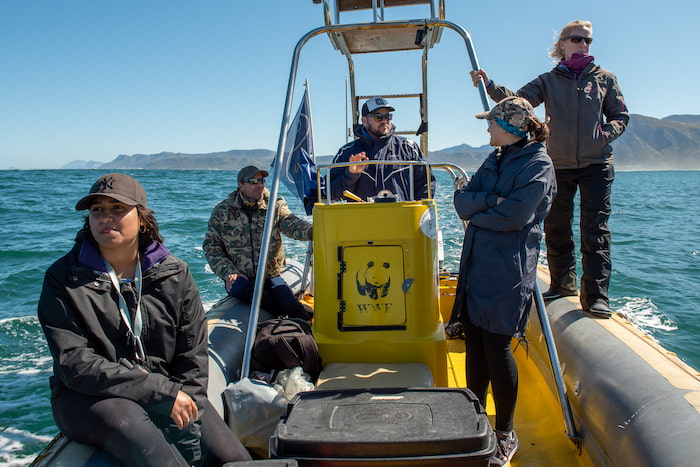
Fieldwork by boat, studying southern right whales
As reported in previous years, sightings of females with calves decreased dramatically in 2015, 2016 and 2017, increased above normal levels in 2018, and then dropped substantially in 2019, 2020 and 2021. Sightings of unaccompanied adults (males and non-calving females) have decreased drastically in 2010 and have not yet returned to normal levels (see Figure 1). This suggests that only pregnant females, which are about to give birth, complete their migration to the South Africa coast to increase their calf’s survival chances, whereas most of the others are not undertaking their migration to the full extent. Additionally, data continues to show that females are giving birth to a calf every 4 to 5 years instead of every 3 years as historically observed. This year’s survey will reveal how these trends continue.
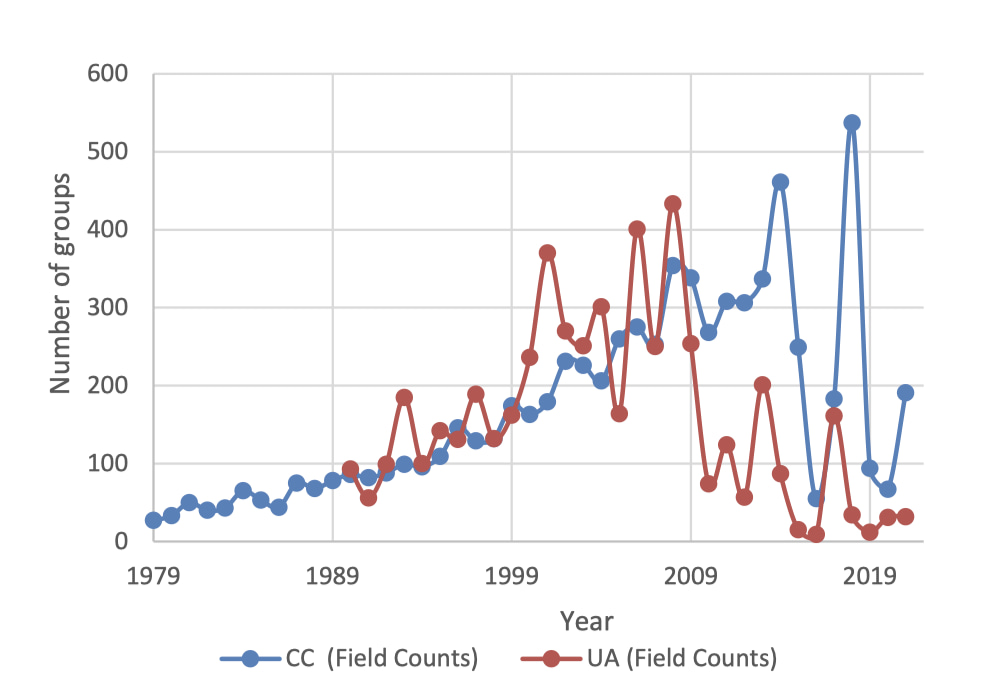
Number of females with calves (CC) and unaccompanied adults (UA) counted on the annual aerial surveys between 1979 and 2021.
The MRI Whale Unit’s 2022 aerial survey will commence on the 1 st of October (weather dependent) and will follow standard survey procedures as described below;
Survey Procedures
The coastal stretch between Nature’s Valley and Muizenberg will be surveyed using a Eurocopter AS350 (Squirrel) at an altitude of approximately 300 m. Flying is only carried out under adequate survey / weather conditions between 08h00 and 16h00 as light and glare outside of these times compromises survey photography. During the survey, all encountered whale species are recorded. Additionally, and most importantly, all southern right whale females with calves, as well as all individuals with distinctive brindle colouration or markings, will be photographed in order to allow individual identification. Vertical images of both the heads and the backs of the animals will be taken, which will allow recognition of the pattern formed by the callosities on their heads, and in some cases of the white and grey pigmentation patterns on their backs. Photography of each group usually takes less than five minutes (but can take up to 15 min), during which time the helicopter decreases in altitude to hover some 150-200 m above the whales. Once sufficient photographs are obtained, the helicopter returns to the 300 m altitude to continue searching for whales, although in areas of high whale densities the aircraft may move directly from group to group at the lower altitude.
After the survey, the collected photographs and associated data will be analysed. The best images of each individual will be selected from each encounter and compared to all other selected images from this survey to search for within-year duplicates, as well as to the Whale Unit’s catalogue of identification photographs of just over 2,600 recognisable adults from the previous 42 annual surveys. Sorting of images is initially done using a computer-assisted image recognition system, followed by final matching of the whales by eye. These analyses allow for sighting histories of known individuals to be compiled and a subsequent investigation of individual movement and distribution patterns as well as the reproductive / calving histories of females. These data will then be used to further investigate the vital parameters of the population, including abundance estimation, population growth rate, survival, calving intervals, and age at first parturition (age at when a female has her first calf), which allows researchers to accurately model the population demographic parameters over the long term.
After the survey, the collected photographs and associated data will be analysed. The best images of each individual will be selected from each encounter and compared to all other selected images from this survey to search for within-year duplicates, as well as to the Whale Unit’s catalogue of identification photographs of just over 2,600 recognisable adults from the previous 42 annual surveys. Sorting of images is initially done using a computer-assisted image recognition system, followed by final matching of the whales by eye. These analyses allow for sighting histories of known individuals to be compiled and a subsequent investigation of individual movement and distribution patterns as well as the reproductive / calving histories of females. These data will then be used to further investigate the vital parameters of the population, including abundance estimation, population growth rate, survival, calving intervals, and age at first parturition (age at when a female has her first calf), which allows researchers to accurately model the population demographic parameters over the long term.

The MRI Whale Unit’s 2022 survey will be flown in association with Silvercross Helicopters, and with the support of the De Hoop Collection, Denel Overberg Test Range, and private citizens along the route. The survey is carried out under a permit from the Department of Forestry, Fisheries and the Environment to approach whales, and under specific Marine Protected Area permits from the relevant conservation authorities. Funding for this survey is provided by TotalEnergies.

